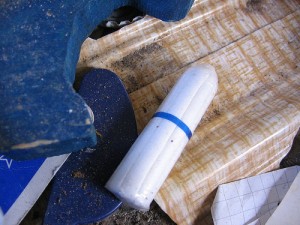Last week at The Art of Manliness, a contributor wrote a post about numerous possible wilderness survival uses of tampons. The post was picked up by the popular site, Boing Boing, and the commenters in both sites added more uses, as well uses for disposable maxi pads (although some contributors seem uncertain of the difference). Many creative uses for disposable femcare products were suggested, and while I can’t personally vouch for (or against) any of them, I offer this post as Public Service Announcement to correct some of the misinformation about tampons and pads that those uses presume.
The use of an opened tampon or a maxi pad for a bandage probably seems obvious to re:Cycling readers, as many are familiar with the history of Kotex, developed when World War I nurses discovered that the cotton cellulose they were using on wounded soldiers was highly absorbent. (The phrase ko-tex stands for cotton texture.) But as a few sharp readers of The Art of Manliness are aware, it has been decades since maxi-pads or tampons of any brand were made of cotton (except, obviously, the all-cotton types sold in health food stores). Pads are made from mostly from wood cellulose fibers, with plastic outer layers made of polypropylene or polyethylene. Some of the newer, improved maxi-pads feature synthetic gels designed to draw blood away from the body — not exactly a feature you’d want in a bandage, when you’re trying to stanch the flow of blood and promote clotting. If you’re bleeding heavily, you’re probably better off tearing off your t-shirt and pressing it against the wound. Tampons are also made of wood cellulose, often with a core of viscose fiber. Viscose fiber is rayon, created by treating cellulose with sodium hydroxide and carbon disulfide.
And although most brands are individually wrapped these days, neither tampons nor pads are sterile. Nor are they produced in sterile conditions. I’d be very leery of using a tampon as a water filter. Surely there are safer, equally portable, emergency filters one could pack in a wilderness survival kit.
Many of the other emergency uses of tampons involved using the fluffy wood pulp as kindling, or otherwise setting them on fire. Now there’s a use I can get behind!


